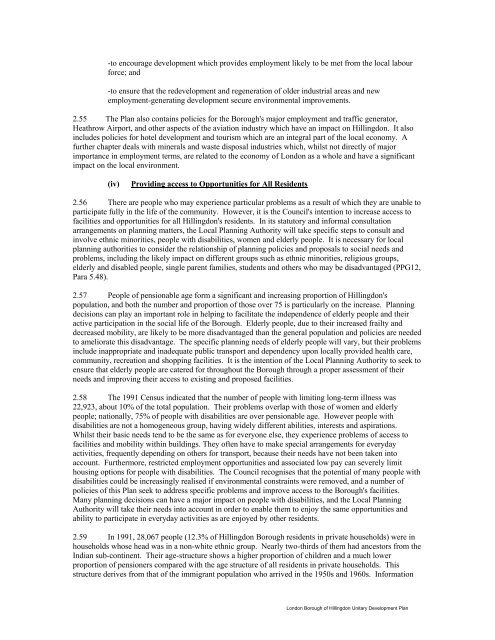HILLINGDON UNITARY DEVELOPMENT PLAN - London Borough ...
HILLINGDON UNITARY DEVELOPMENT PLAN - London Borough ...
HILLINGDON UNITARY DEVELOPMENT PLAN - London Borough ...
You also want an ePaper? Increase the reach of your titles
YUMPU automatically turns print PDFs into web optimized ePapers that Google loves.
-to encourage development which provides employment likely to be met from the local labour<br />
force; and<br />
-to ensure that the redevelopment and regeneration of older industrial areas and new<br />
employment-generating development secure environmental improvements.<br />
2.55 The Plan also contains policies for the <strong>Borough</strong>'s major employment and traffic generator,<br />
Heathrow Airport, and other aspects of the aviation industry which have an impact on Hillingdon. It also<br />
includes policies for hotel development and tourism which are an integral part of the local economy. A<br />
further chapter deals with minerals and waste disposal industries which, whilst not directly of major<br />
importance in employment terms, are related to the economy of <strong>London</strong> as a whole and have a significant<br />
impact on the local environment.<br />
(iv)<br />
Providing access to Opportunities for All Residents<br />
2.56 There are people who may experience particular problems as a result of which they are unable to<br />
participate fully in the life of the community. However, it is the Council's intention to increase access to<br />
facilities and opportunities for all Hillingdon's residents. In its statutory and informal consultation<br />
arrangements on planning matters, the Local Planning Authority will take specific steps to consult and<br />
involve ethnic minorities, people with disabilities, women and elderly people. It is necessary for local<br />
planning authorities to consider the relationship of planning policies and proposals to social needs and<br />
problems, including the likely impact on different groups such as ethnic minorities, religious groups,<br />
elderly and disabled people, single parent families, students and others who may be disadvantaged (PPG12,<br />
Para 5.48).<br />
2.57 People of pensionable age form a significant and increasing proportion of Hillingdon's<br />
population, and both the number and proportion of those over 75 is particularly on the increase. Planning<br />
decisions can play an important role in helping to facilitate the independence of elderly people and their<br />
active participation in the social life of the <strong>Borough</strong>. Elderly people, due to their increased frailty and<br />
decreased mobility, are likely to be more disadvantaged than the general population and policies are needed<br />
to ameliorate this disadvantage. The specific planning needs of elderly people will vary, but their problems<br />
include inappropriate and inadequate public transport and dependency upon locally provided health care,<br />
community, recreation and shopping facilities. It is the intention of the Local Planning Authority to seek to<br />
ensure that elderly people are catered for throughout the <strong>Borough</strong> through a proper assessment of their<br />
needs and improving their access to existing and proposed facilities.<br />
2.58 The 1991 Census indicated that the number of people with limiting long-term illness was<br />
22,923, about 10% of the total population. Their problems overlap with those of women and elderly<br />
people; nationally, 75% of people with disabilities are over pensionable age. However people with<br />
disabilities are not a homogeneous group, having widely different abilities, interests and aspirations.<br />
Whilst their basic needs tend to be the same as for everyone else, they experience problems of access to<br />
facilities and mobility within buildings. They often have to make special arrangements for everyday<br />
activities, frequently depending on others for transport, because their needs have not been taken into<br />
account. Furthermore, restricted employment opportunities and associated low pay can severely limit<br />
housing options for people with disabilities. The Council recognises that the potential of many people with<br />
disabilities could be increasingly realised if environmental constraints were removed, and a number of<br />
policies of this Plan seek to address specific problems and improve access to the <strong>Borough</strong>'s facilities.<br />
Many planning decisions can have a major impact on people with disabilities, and the Local Planning<br />
Authority will take their needs into account in order to enable them to enjoy the same opportunities and<br />
ability to participate in everyday activities as are enjoyed by other residents.<br />
2.59 In 1991, 28,067 people (12.3% of Hillingdon <strong>Borough</strong> residents in private households) were in<br />
households whose head was in a non-white ethnic group. Nearly two-thirds of them had ancestors from the<br />
Indian sub-continent. Their age-structure shows a higher proportion of children and a much lower<br />
proportion of pensioners compared with the age structure of all residents in private households. This<br />
structure derives from that of the immigrant population who arrived in the 1950s and 1960s. Information<br />
<strong>London</strong> <strong>Borough</strong> of Hillingdon Unitary Development Plan
















